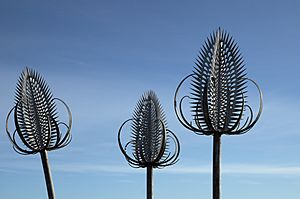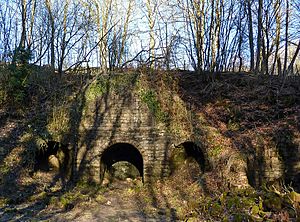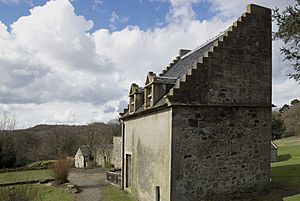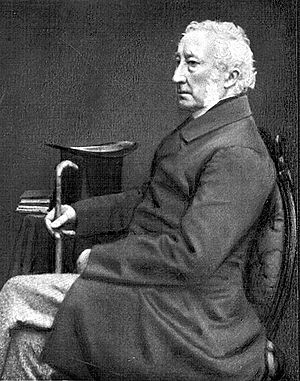Muiravonside Country Park facts for kids
Quick facts for kids Muiravonside Country Park |
|
|---|---|

Three Teasels sculpture
|
|
| Type | Country park |
| Location | south-east corner of Falkirk (council area) |
| Nearest town | Linlithgow |
| Area | 170 acres |
| Created | 1977 |
| Open | All year |
Muiravonside Country Park is a huge park in Scotland, covering 170 acres! It's full of woodlands and open spaces, perfect for exploring. You can visit all year round and enjoy its many trails, picnic spots, and a fun play area. The park is located in the south-east part of the Falkirk area, not far from towns like Linlithgow and Armadale. This beautiful park used to be the private land of Muiravonside House, owned by the Stirling family.
Contents
Discover Muiravonside Country Park
Muiravonside Country Park is part of the River Avon Heritage Trail. This trail takes you past cool historic spots like the Avon Aqueduct. You can also see old industrial and farming relics. These include a Lime Kiln, a sawmill powered by water, and a restored 17th-century dovecot. A dovecot is a building where pigeons or doves were kept.
The park's old Home Farm is now the visitor centre, though it's currently being updated. Newparks Farm has been turned into an animal attraction. Here you can see many different kinds of animals and birds. Over 90 types of birds have been spotted in the park! In 2016, the park got money to make its trails even better. They also added seven special sculptures for visitors to enjoy.
Muiravonside's Long History
The land that is now Muiravonside Country Park has a very long history. It dates back to 1189! Back then, a man named Reginald Prat de Tindale gave the estate to his daughter, Margaretta. This was a wedding gift when she married Richard de Miville. The main part of the estate was an old castle called 'Maiden Castle'. It's now in ruins, just outside the park. Around this time, the area was known as "Murgunessete," which means 'the home of Morgan'.
The Ross Family Era
In 1471, the estate became part of the Ross family through marriage. Sir John Ross, who was next in line to own the estate, sadly died in a big battle in 1513 called the Battle of Flodden. The Ross family continued to own the estate for many years. During their time, the first Muiravonside House was built in 1609. This house was made bigger in the 1700s and 1800s.
The MacLeod Family and a Secret
In 1724, the estate was sold to John MacLeod, a lawyer from Edinburgh. The MacLeod family had a history of supporting the Stuart family, who wanted to return to the throne. Alexander McLeod, who lived at Muiravonside, was a close helper to Bonnie Prince Charlie. Bonnie Prince Charlie was a famous leader who tried to reclaim the throne for the Stuarts.
Before the Jacobite rising of 1745, these Stuart supporters were planning their return. A friend of the MacLeods, James Erskine, Lord Grange, was also involved. His wife, Rachel Chiesley, Lady Grange, threatened to tell everyone about his secret plans. Because of this, she was taken away on January 22, 1732. She was held at Muiravonside House for a short time. After that, she was moved to very remote islands off the west coast of Scotland.
The Stirling Family and Park Creation
In 1835, the estate was sold to Charles Stirling. He had sixteen children, including General Sir William Stirling. This was a time when farming methods were improving in Scotland. Charles Stirling wanted his estate to be as self-sufficient as possible. He built the lime kilns you can still see in the park today. He also had his own clay drain works. He changed an old grain mill into a sawmill. Charles also managed the Muiravonside Coalfield, which had been working since the 1700s.
When Charles died in 1867 at Muiravonside, his eldest son, Andrew, who was a lawyer, inherited the estate. During World War I, 11 British soldiers stayed in the house, which was partly rented out by then. Thomas Willing Stirling was the last Stirling to be buried in the family burial ground on the estate. He died in 1930. The estate then went to his eldest son, Sir Arthur Charles Stirling. He lived there until he died in 1967.
Sir Arthur Charles wanted his sister to inherit the estate because he had no sons. However, his cousin, Sir Norman Charles Stirling, disagreed. This led to a long legal battle. Ten years later, the case was decided in favor of Sir Arthur Charles's wishes. By then, the house was in ruins. It would have cost a lot of money to fix the estate. The new owner was quite old and didn't have a strong connection to the estate. So, in 1977, she sold part of it to the local council. The once grand Muiravonside House was considered unsafe and was taken down. This was part of turning the estate into Falkirk's first country park in the 1970s.
In 1980, the Countryside Ranger Service started its work. Their job is to teach people about the park and keep its woodlands and paths in good condition. They have also helped install the sculptures you can see around the park today.




